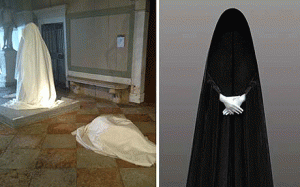I was invited by the Ministry of Culture of Azerbaijan to be the advisory curator of the exhibition of Azerbaijan Pavilion in 54th Venice Biennale. From September 2010 on I have worked with Mr. Chingiz Farzaliev, who acted as commissar and local curator. All the works of these artists have been evaluated in meetings in Baku and Venice. Aidan Salakhova has presented her sculptures in every detail which have been produced in Carrara and these works together with the works of the artist have been published in the catalogue and announced in the website from April 2011 on.
31st of May, when I came to the pavilion I was informed that Ministry of Culture has found Salakhova’s two sculptures which were installed in the entrance of the Palazzo controversial to the prestige of the country.
Aidan Salakhova and me, we felt very concerned and responsible of the image of the exhibition and respecting the position of the other artists we tried to be positive and find a solution. As it could not be removed during the opening days, the sculptures were covered with textile. Until 5th of June, every day we have discussed with the authorities and responsible people of the pavilion and explained that:
-Removing the sculpture will mean “censorship” and it will do more harm to the image of the country than the sculpture itself; it would be much effective, if the officials would place a label next to the sculpture and declare that the authorities are not acknowledging and approving the form, message or concept of this sculpture, that it is the interpretation of the artist.
-The concept of the sculptures has been misinterpreted and misjudged by the authorities or by their advisers; all symbols, signs, objects Salakhova is using have a historical and traditional knowledge and anchorage.
-The meaning and message of this work is extensively explained in my catalogue text and is eventually the artist’s interpretation of “being woman under the religious dictums”; here the religion is not only related to Islam but also to Orthodoxy and other religions, which before Islam introduced the veil;
-The selection of artists and the works have been made by me and by Mr. Farzaliev with utmost responsibility and prudence; during this process there was not one negative hint that came on Salakhova’s work.
-The Venice Biennale is a platform for extreme artistic freedom, for sensitive topics, for limitless criticism; therefore all countries must consider and accept this context before participating.
However, we were not able to convince and stop the removal of these sculptures.
In my 25 years of curating profession, I have never experienced this kind of conflict. However, lately I am observing – probably most of my colleagues also do – the growing intrusion of the political and official power on contemporary art production and on the artists and curators in many countries, including the developed democracies. Contemporary art production and its theoretical and critical context is being employed and exploited by the official power as well as by the private sector as a tool for high prestige and glory; but at the same time its content and concepts are not tolerated and acknowledged.
We in the production sector of contemporary art are witnessing and enduring this use/abuse process. We release protests and supports for the victims of these attitudes. Journalists investigate and write about it. However, at the end the damage is done and the artist or the curator suffers.
In the case of Azerbaijan Pavilion, I think from now on this is the problem of the artists and curators living and working in Azerbaijan. I have done my best, to bring the Azerbaijan contemporary art production into the agenda of international contemporary art; however I must acknowledge that I was naive and I failed. The artists, art critics and curators in Azerbaijan should act and liberate art making, art production and creative criticism and take their long deserved position in the international art.
On the other side, this is also becoming a general problem in the art world and I think the artists and curators should have an international legal protection against these conflicts.
Beral Madra
Tuesday, 07 June 2011


